Boundary of a Set
The boundary of a subset A in a topological space X is the set of points that belong to the closure of A but not to its interior. ∂A=Cl(A)−Int(A)
Where Cl(A) is the closure of A, which includes all the points in A and its limit points.
Meanwhile, Int(A) is the interior of A, consisting of all points in A that have a neighborhood entirely contained within A.
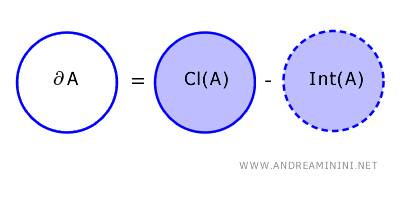
It's essential to reiterate that the concept of a boundary is not an intrinsic property of a set; it depends on the topology employed.
Thus, the boundary of a set can vary when a different topology is utilized.
In other words, the boundary of a set A consists of the points that are "close" to both the set A and its complement X∖A.
A Practical Example
Consider the set A=(0,1) as a subset of the real line R in the standard topology.
Let's determine the boundary of A.
1] Calculate the Closure of A
The closure of A, denoted Cl(A), includes all the points in A and its limit points.
For A=(0,1), the closure is the closed interval [0,1] because every point in the interval (0,1) is a limit point, and the points 0 and 1 are the endpoints of the interval.
Cl(A)=[0,1]
2] Calculate the Interior of A
The interior of A, denoted Int(A), consists of all points in A that have a neighborhood entirely contained within A.
For A=(0,1), the interior is the same set (0,1) because every point within the open interval has a neighborhood entirely within (0,1).
Int(A)=(0,1)
3] Calculate the Boundary of A
The boundary of A, denoted ∂A, is defined as the set difference between the closure of A and its interior:
∂A=Cl(A)−Int(A)
Using the results from the previous steps:
∂A=[0,1]−(0,1)={0,1}
Therefore, in the standard topology on R, the boundary of the set A=(0,1) is the set of points {0,1}.
These two points are close to both the interior and exterior of A, thus representing the boundary of the set.
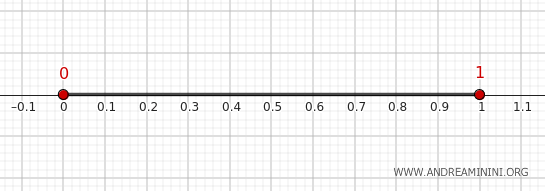
The Boundary Theorem
A point x in a topological space X belongs to the boundary x∈∂A of a subset A if and only if every neighborhood of x intersects both A and X−A.
According to this theorem, to determine if a point x belongs to the boundary of a set A, you check if every neighborhood of x intersects both A and X−A.
Example
Consider the set A=(0,1) on the real line R with the standard topology.
The closure and interior of this set are:
Cl(A)=[0,1]
Int(A)=(0,1)
Thus, the boundary of the set A consists only of the points 0 and 1.
∂A=Cl(A)−Int(A)=[0,1]−(0,1)={0,1}
Let's verify if the points 0 and 1 belong to the boundary using the previous theorem.
1] Check Point 0
Consider a neighborhood of zero, (0−ϵ,0+ϵ) with ϵ>0.
This neighborhood intersects A because every neighborhood of 0 contains points in (0,1).
The neighborhood also intersects X−A, which is (−∞,0]∪[1,∞), as it contains points less than 0.
Since every neighborhood of 0 intersects both A and X−A, we conclude that 0∈∂A.
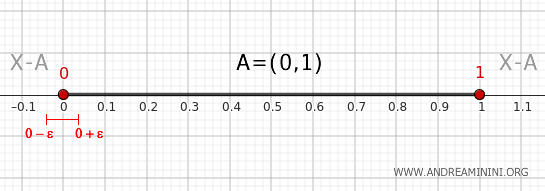
2] Check Point 1
Consider a neighborhood of 1, for instance, the interval (1−ϵ,1+ϵ) with ϵ>0.
This neighborhood intersects A because every neighborhood of 1 contains points in (0,1).
The neighborhood also intersects X−A, which is (−∞,0]∪[1,∞), as it contains points greater than 1.
Since every neighborhood of 1 intersects both A and X−A, we conclude that 1∈∂A.
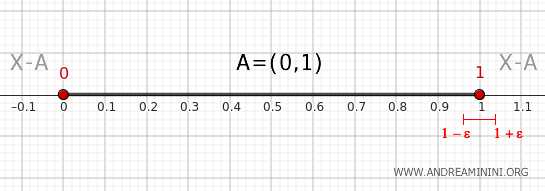
3] Check a Point Within (0,1)
Consider any point within the interval (0,1).
For example, the interval (0.5−ϵ,0.5+ϵ) with ϵ>0.
This neighborhood intersects A because every neighborhood of 0.5 contains points in (0,1).
However, this neighborhood does not intersect X−A because all points within this neighborhood belong to A.
Since there is a neighborhood of 0.5 that does not intersect X−A, we conclude that 0.5∉∂A.
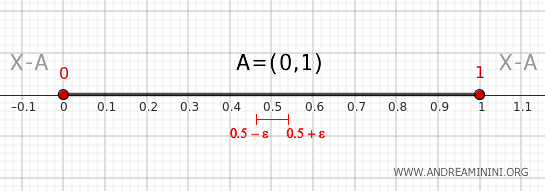
In conclusion, using the theorem, we verified that the points 0 and 1 belong to the boundary of A=(0,1), while an interior point like 0.5 does not. This confirms that the boundary of A is {0,1}.
Notes
Some observations and additional notes on set boundaries:
- Boundary ∂A is a subset of A if and only if A is closed:
∂A⊆A⇔A è chiuso - Intersection of the boundary and the set A is empty if and only if A is open
In other words, a set A is open if and only if none of its points lie on its boundary.
∂A∩A=∅⇔A is open - Boundary ∂A is empty if and only if A is both open and closed (clopen):
∂A=∅⇔A is clopen - Boundary ∂A coincides with the intersection of the closure of A and the closure of X−A:
∂A=Cl(A)∩Cl(X−A) - Boundary ∂A is always a closed set
The intersection of two closed sets is always a closed set, which is a fundamental property in topological spaces. Since ∂A is defined as the intersection of the two closed sets Cl(A) and Cl(X−A) ∂A=Cl(A)∩Cl(X−A) we can therefore conclude that ∂A is always closed.
- Intersection of the boundary ∂A and the interior Int(A) is empty:
∂A∩Int(A)=∅ - Union of the boundary ∂A and the interior Int(A) is equal to the closure of A:
∂A∪Int(A)=Cl(A)
And so on.
